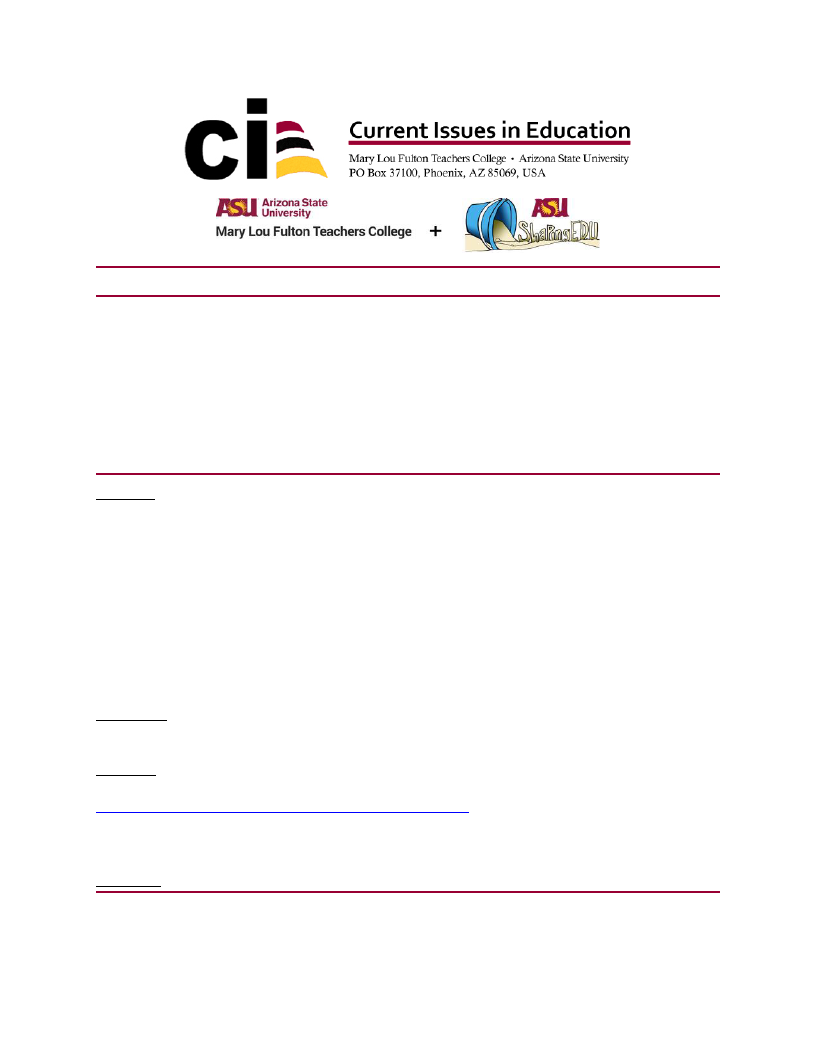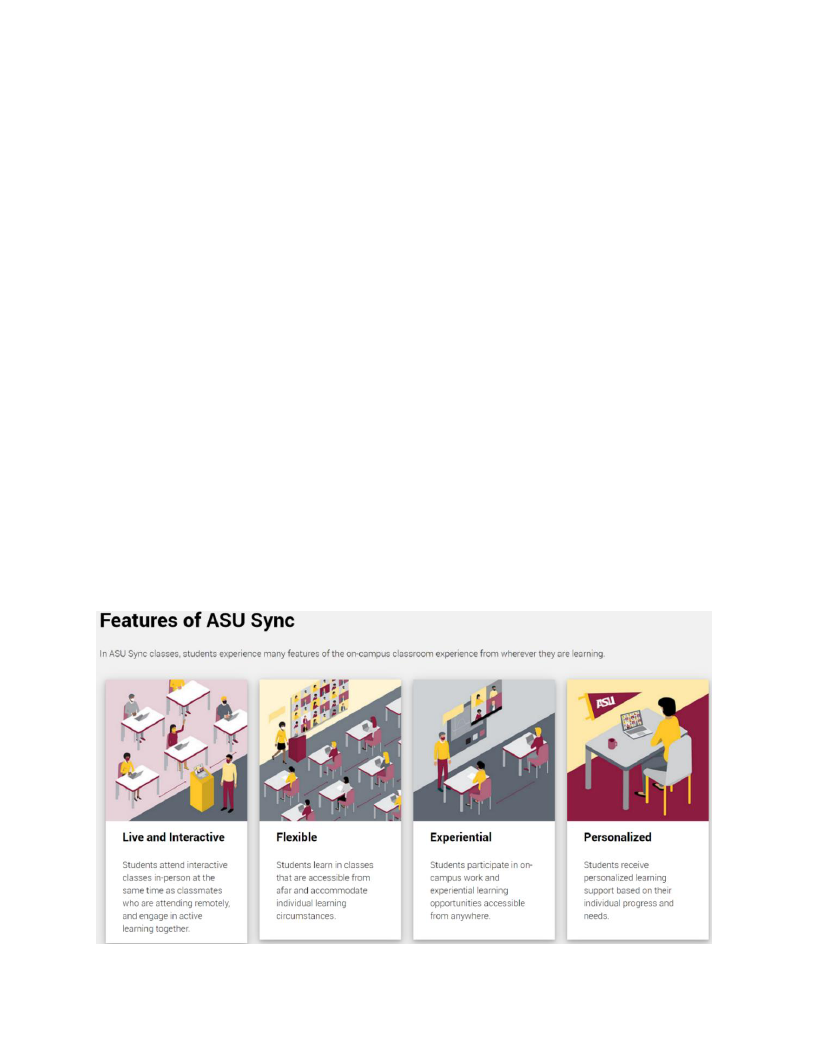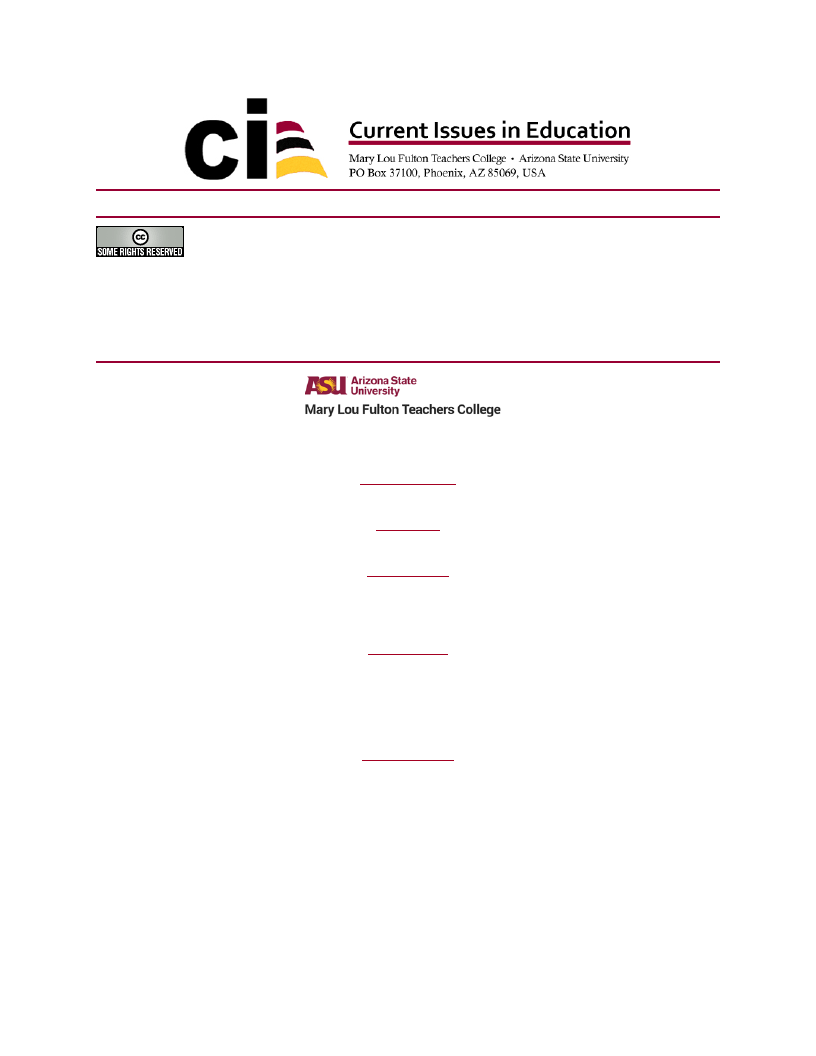
Volume 22, Issue 1
January 7, 2021
ISSN 1099-839X
Shaping the Futures of Learning in the Digital Age
Inclusive Campus Environments:
An Untapped Resource for Fostering Learner Success
Susan Whitmer
Susan Whitmer Studios
Abstract: The purpose of this paper is to consider new possibilities for higher education, where the
principles of Universal Design for Learning (UDL) provide a framework for creating digital and
physical environments that honor every learner’s unique lived experiences and support the
expectations of learners for their individual life goals. Each learner brings their own unique lived
experience; multi-level intersectionality; and cognitive and social learning variabilities to their
educational journey. Many of these present obstacles to their realizing successful learning
outcomes. Understanding the lived experiences in the learner’s journey and creating environments
that remove barriers to learning requires a deep understanding of inclusion, which is central to the
framework of UDL. How can we create a campus that promotes a sense of belonging, community,
and well-being — a campus that has the potential to increase the number of learners who persist
to completion? It begins with honoring the uniqueness of every learner.
Keywords: Universal Design for Learning, Inclusion, Community, Sense of Belonging, Social
Justice
Citation: Whitmer, S. (2021). Inclusive campus environments: An untapped resource for fostering
learner success. Current Issues in Education, 22(1). Retrieved from
http://cie.asu.edu/ojs/index.php/cieatasu/article/view/1902 This submission is part of a special
issue, Shaping the Futures of Learning in the Digital Age, guest-edited by Sean Leahy, Samantha
Becker, Ben Scragg, and Kim Flintoff.
Accepted: 11/9/2020
Current Issues in Education, 22(1)
1

Whitmer: Inclusive Campus Environments
Introduction
The force factors of the COVID-19 pandemic, the rise of social injustice, and political
polarization have deepened the erosion of trust and confidence in the value of higher education
and in our society. In May of 2020, the American Association of Colleges & Universities
(AAC&U) convened a panel of higher education leaders to discuss the opportunities that exist by
shifting our mindset from a traditional model, ruled by categories and silos, to the possibilities
that exist in a culture that values equity, diversity, inclusion, and human dignity. In the words of
panelist Daniel Pascoe Aguilar, “Part of our work in preparing a new generation of leaders is to
work with our students to help them understand the value of diversity, equity, and inclusion. It is
not only an important part of their realities and experiences, but as an asset to our decision-
making and as an asset to our effective performance as individuals, as organizations, as nations,
and as a world” (AAC&U, 2020).
The Learner’s Journey
The principles of Universal Design for Learning (UDL) provide a framework for creating
digital and physical environments that honor every learner’s unique lived experiences and
supports the expectations of learners for their individual life goals. Each learner brings their own
unique lived experience; multi-level intersectionality1 and cognitive and social learning
variabilities to his/her/their educational journey. Many of these present obstacles to their
realizing successful learning outcomes. Learners on the journey are racially and ethnically
diverse, and identify as: LBGTQ+; first-generation learners; veterans; older adults; international
learners; learners with physical disabilities, neuro-diversities2 and mental health challenges; and
learners with housing and food insecurities.
Understanding the lived experiences in the learner’s journey and creating
environments that remove barriers to learning requires a deep understanding of inclusion.
Inclusion is a broad umbrella of social justice requirements such as antiracism, equity,
accessibility, and diversity. There is no inclusive campus ecosystem without addressing
these social justice requirements.
Recent data on learners’ diverse variabilities highlights potential challenges for learners:
• As of the academic year 2015-2016, 56% of undergraduate students, defined as first-
generation students, had parents who did not have a bachelor’s degree (RTI
International, 2019).
• From 2000 to 2018, college enrollment rates among 18- to 24-year-olds increased for
those who were Black (from 31% to 37%) and Hispanic (from 22% to 36%). The
college enrollment rate was not measurably different between 2000 and 2018 for
those who were American Indian/Alaska Native, but rates were lower in 2018 than in
2010 for those who were American Indian/Alaska Native (24% vs. 41%; NCES,
2020).
1 Kimberlé Crenshaw, who coined the term intersectionality, describes the current context of the term as “a lens, a
prism, for seeing the way in which various forms of inequality often operate together and exacerbate each other”
(Steinmetz, 2020).
2 Neurodiversity refers to neurological differences in how the brain organizes and responds to stimuli. Dyslexia,
Attention Deficit Hyperactivity Disorder, Autistic Spectrum Disorders, Tourette Syndrome, and others are included
in the concept of neurodiversity. https://neurodiversitysymposium.wordpress.com/what-is-neurodiversity/
Current Issues in Education, 22(1)
2

Whitmer: Inclusive Campus Environments
• A 2016 survey of more than 33,000 students by the American College Health
Association found that 10% identified as gay, lesbian, bisexual, trans, asexual,
pansexual, or questioning (Best Colleges, 2020).
• Sixty-eight percent of Post-9/11 veterans do not have a bachelor’s degree or higher.
Of the 32% who do, 20% of the degrees were attained at for-profit institutions (Cate
et al., 2017).
• The number of international students in the US reached 1.09 million in 2018
(Education USA, 2018).
• Ninety-four percent of learners with learning disabilities receive accommodations in
high school, compared with 17% in college3 (Cortiella & Horowitz, 2014).
• Researchers estimate that 30-50% of students attending post-secondary education
experience food insecurities at some point during their school year (Ciciora, 2019).
• Research on housing insecurities indicates “at least one-third of 2-year students are
housing insecure, including up to 14% who are homeless, whereas between 11% and
19% of 4-year students are housing insecure” (Broton & Goldrick-Rab, 2018).
A learner-centric framework for creating inclusive physical and digital environments
requires an awareness of what learners need from a campus ecosystem that recognizes the
realities of neurodiversity, social justice, multi-level intersectionality, and cognitive, social, and
physical well-being. As shown in Figure 1, Maslow’s (1943) Hierarchy of Needs provides a
mental map for developing inclusive solutions that support every learner:
Figure 1
Maslow’s Hierarchy of Needs
3 To receive accommodations in higher education, the student must contact the Disability Resource Office and
complete a process to be accepted for accommodation. This process is referred to as self-advocate.
Current Issues in Education, 22(1)
3

Whitmer: Inclusive Campus Environments
The positive and negative implications for Maslow’s Hierarchy of Needs are incorporated
into the principles and strategies of UDL. Unmet needs lead to anxiety and depression, which are
among the biggest factors that negatively affect academic performance.
Food and housing insecurities are those hidden struggles that harm the physical,
emotional, and mental well-being of learners, and negatively impact their academic performance
and their desire to persist. Research indicates there is a statistically significant relationship
between food and housing insecurities, a learner’s academic performance, and persistence to
completion (Goldrick-Rab et al., 2018; Martinez et al., 2016).
Learners perform better when they feel safe in their environment. The rise in racist
violence and cyber-bullying makes safety top of mind for learners, whether the learning
environment is physical or digital. An inclusive environment is a place where all learners,
regardless of their lived experiences and learning variabilities, feel safe to engage with peers
academically and socially, without fear for personal safety. An inclusive environment is also one
where learners feel emotionally and mentally safe to fail, fail fast, and recover, so they develop
the resilience necessary to thrive in their chosen career. This type of support leads to the
development of a sense of belonging.
Sense of belonging, connectedness, and community take on heightened importance for
learners who are traditionally underserved.4 A sense of belonging is defined by author Terrell
Strayhorn (2019): “students’ perceived social support on campus, a feeling or sensation of
connectedness, and the experience of mattering or feeling cared about, accepted, respected,
valued by, and essential to the group (e.g., campus community) or others on campus (e.g.,
faculty, peers)”. Feeling accepted for their uniqueness and being connected to the campus
community expands opportunities for the positive outcomes of engagement, improved
performance, well-being, and persistence to completion.
The current organizational mindset of higher education puts a roadblock on the journey to
becoming a unique individual, which creates policies, curricula, campus planning, and metrics of
success based on the false notion of the “average” learner. The average learner does not exist: no
two brains are alike, and all learners bring their own lived social and cultural experiences to the
learning community (Rose, 2016). If, as Maslow argues, developing healthy self-esteem and
empowerment is a result of honoring the uniqueness of every individual, then the organization
bears responsibility for creating physical and digital environments that are welcoming and safe
for all learners. As with every big challenge facing administrators, faculty, instructional
designers, and technology developers, there is no one-size-fits-all solution for teaching and
learning. There is a framework, however, that provides sustainable strategies for educators across
the learning spectrum that empowers all learners to activate a passion for lifelong learning.
Universal Design for Learning Framework
Universal Design for Learning (UDL) is a framework based on research in the learning
sciences (e.g., education, educational psychology) and the brain sciences (e.g., cognitive science
and neuroscience). UDL calls for an emphasis on honoring the uniqueness of every learner and
their lived experience. Although UDL does not explicitly call out all the social, psychological,
and emotional barriers to learning, the strategies and guidelines within the UDL framework
4 Underserved students can include learners with disabilities, veterans with Post-Traumatic Stress Disorder (PTSD),
students with Autism Spectrum Disorder (ASD), international students, first-generation students, students in the
LGBTQ+ community, students in racially and ethnically minorities, and others.
Current Issues in Education, 22(1)
4

Whitmer: Inclusive Campus Environments
provide pathways for addressing the barriers in learning and removing the obstacles in the path
of becoming an expert learner.
The UDL framework clearly establishes three principles that correlate to the organized
structure of the brain (Kurzweil Education, 2019):
1. Multiple means of engagement-tap into learners' interests, offer appropriate
challenges, and increase motivation.
2. Multiple means of representation-give learners various ways of acquiring
information and knowledge.
3. Multiple means of expression-provide learners alternatives for demonstrating
what they know.
In her recent book Antiracism and Universal Design for Learning, Andratesha Fritzgerald
(2020, p. 24) provides a summary of the 2018 UDL guidelines that help educators create
instructional pathways that are flexible, customizable, and culturally sustainable. Such pathways:
• activate or supply background knowledge,
• highlight patterns, critical features, big ideas, and relationships,
• foster collaboration and community,
• vary the methods for response and navigation,
• promote expectations and beliefs that optimize motivation,
• facilitate personal coping skills and strategies,
• heighten salience goals and objectives,
• promote understanding across languages,
• optimize relevance, value, and authenticity, and
• minimize threats and distractions.
Curricula, assessments, and classroom management practices must be developed with
these principles and guidelines in mind for learners to establish a sense of belonging, boost their
self-esteem, and cultivate their self-actualization. Adoption of pedagogical practices based on
research on how learning happens have elevated the need to introduce research-based practices
that recognize cognitive and social learning variabilities.
Consider a neuro-diverse learner, a veteran with PTSD, an international learner, or a
learner whose lived experience is at the intersection of all three identities. Each of these learners
may have elevated levels of stress in active learning environments due to the expectation of
higher levels of engagement. Opportunities to mitigate their stress include: 1) engage with all
learners, 2) open opportunities to guide learners who need help with the team or group dynamics,
3) find ways to introduce content into coursework or physical/digital environments that connect
diverse learners’ lived experiences and cultures to the content, 4) organize the environment to
promote predictable routines and transitions, and 5) give learners a choice for how and where
they like to work in the learning environment.
The UDL principles and strategies can also serve as guideposts for designing physical
and digital environments in the education ecosystem. Legibility is a crucial element of inclusive
physical and digital environments. On an inclusive campus, no matter where the daily journey
takes the learner, walkways and paths should be physically accessible. Paths should include
established edges that create order, and physical cues should provide wayfinding, fostering a
Current Issues in Education, 22(1)
5

Whitmer: Inclusive Campus Environments
connection from one building to the next. Examples of physical cues are sculptures, cultural
artifacts, and digital dashboards. The spaces within the buildings themselves should be
straightforward and easy to navigate. Inclusive environments have surroundings, furniture, and
tools that help learners understand how the space will support their activities and behaviors.
What learners see in the environment around them, such as physical artifacts and messaging, tells
them whether they belong or not.
Inclusive Environments Activated
Remote learning in 2020 has amplified the barriers of the digital divide that has existed
for many years. The difference is that pre-COVID-19, these barriers had not been acknowledged
in the US to the extent they have in other parts of the world. And even when learners have access
to a computer and hours of Zoom classes, inequities are amplified in the disparity of what is in
the physical background of every learner’s space. Many learners hesitate to join a class with their
camera on because they are embarrassed by the environment around them, adding to the stress
and anxiety that already exists. At a very basic level, a shift in mindset that focuses more on the
learner and less on traditional practices would permit the learner to join with their camera off.
And in the spirit of new possibilities, curated virtual backgrounds that replicate an inclusive
environment where no one is judged, and everyone feels welcomed, should exist.
A more robust platform for inclusive learning is developed at Arizona State University
(ASU). ASU Sync is described as a platform that “provides students with technology-enhanced,
fully interactive remote learning using live lectures via Zoom. This approach can be combined
with in-person instruction to accommodate students in various circumstances and enable social
distancing measures in classrooms, or as stand-alone technology. It offers the benefits of face-to-
face instruction in an interactive group learning environment” (Arizona State University, 2020).
Figure 2
Features of ASU Sync
Current Issues in Education, 22(1)
6

Whitmer: Inclusive Campus Environments
Consider the learner who might be struggling with food or housing insecurities.
Providing a food pantry and a “nap space” where learners with housing insecurities can rest if
needed can make all the difference in performance and persistence for these learners. One
example of this type of space is located in the Wellness Suite of the Lola & Rob Salazar Student
Wellness Center at the University of Colorado (UC) Denver (2019). The Wellness Suite is
socialized across campus as well as the UC Denver website so that learners are aware that there
is a place where they can go for food and respite. In addition to providing physical spaces on
campus that support learners with these insecurities, UC Denver is developing a framework for
empowering learners to have a voice in policies that impact their lived experiences.5 The Lola &
Rob Salazar Student Wellness Center is an exemplary model for learner support spaces that are
clearly defined, foster a sense of belonging, build community, and add to the legibility of the
campus.
Permeability, defined as the ability to be passed through, is another crucial element of
inclusive physical and digital environments. Environments that are permeable support the
connection between learners’ academic content, activities, and experiences throughout their
learning journey, anytime, anywhere. A permeable campus reduces barriers to learner interaction
both physically and digitally, reduces cognitive stress, and fosters a sense of belonging and
community. For the digital experience, the ASU Sync platform provides a model for how a
learner’s experience can exist in a digital environment and permeate to the physical. ASU has
also developed a digital campus using collaboration hub, Slack. It is described as a way for
learners to connect with each other and their faculty through real-time messaging, content
sharing, and learning6.
Interdisciplinary programs can provide connectivity of content, but often the learners’
experience building-to-building across the campus is not permeable. One example of
permeability on the physical campus is in common spaces in corridors just outside of or adjacent
to classrooms, where students can continue discussions after a class or talk to faculty before or
after class. When these spaces are designed for every academic building on campus, the campus
becomes more permeable.
Other examples of permeable spaces are the multi-sensory spaces near the classroom.
Multi-sensory spaces are quiet spaces that provide respite for learners who might need a few
minutes to decompress or to soothe their anxieties brought on by the chaotic motions of active
learning. Multi-sensory spaces are designed according to specific lighting and acoustic properties
that help to relieve anxiety and stress. Locating multi-sensory spaces in every building on
campus serves the social and quiet activities that are part of every learner’s experience. A
variation of multi-sensory spaces could serve international learners as a safe and comfortable
environment for private connections to their families. Anecdotal evidence has shown that many
international learners sit in dingy, dark stairwells to Skype with their families because it is the
only quiet, available space where they feel they can share family time. Multi-sensory or safe
quiet spaces should be considered in the library, student center, wellness centers, and residence
halls.
An environment that is ideal for modeling inclusive practices is makerspaces. Well
designed and curated makerspaces offer opportunities to make the principles of UDL actionable
and on display. Makerspaces offer learners multiple means of engagement—they tap into
5 https://www.youtube.com/watch?time_continue=124&v=LXS91jaNkeQ
6 https://uto.asu.edu/slack
Current Issues in Education, 22(1)
7

Whitmer: Inclusive Campus Environments
learners’ interests, offer appropriate challenges, increase motivation, offer multiple means of
representation, provide different ways of acquiring information and knowledge, offer multiple
modes of expression, and provide learners alternatives for demonstrating what they know.
Makerspaces are chaotic due to the nature of the engagements within them. Makerspaces
should be: welcoming; legible, meaning that there is a balance of chaos and order; safe; and
supportive of learners who need consistency to learn and perform at their best. It is the activity of
making that is the most essential ingredient of makerspaces, so it is the activities that become the
permeable agent from the Engineering building to the Fine Arts building to the Library. A
learner should be able to connect their journey through the learning activities of makerspaces
across campus (and across the curriculum), no matter the physical form, scale, or complexity of
the spaces.
While makerspaces have great potential to build and support an inclusive campus culture,
research suggests that work must be done to better promote a sense of belonging in makerspaces
(Melo, 2020; Wood, 2018). The origins of makerspaces, centered around a narrow gender and
ethnic community of makers, has manifested into the culture and design of the current
makerspace framework, which has been slow to fully embrace inclusivity. Melo (2020) writes,
“Makerspaces are both physically and ideologically at odds with serving racially, economically,
and gender diverse communities.” As innovation environments like makerspaces continue to
evolve, there is a need for greater inclusivity in their design.
Creating an inclusive campus environment that is legible, permeable, and enacts inclusive
classroom management practices can only succeed by using a blended approach that includes the
digital experience: digital dashboards that serve as landmarks in every building, campus maps
with rich wayfinding graphics, spaces and tools that support digital maker activities, layered
technologies in learning spaces, and personal technologies that enhance the learning experiences
of neuro-diverse learners—these are just a few examples of integrating the physical and digital
campus experiences.
Measuring what matters is essential. Assessing the performance of an inclusive
campus environment requires evaluation of space and building performance based on
how well the physical, social, and cognitive needs of all learners are being met.
Additionally, assessing performance requires an evaluation of curricula to make sure
coursework is designed to engage all learners through multiple means of engagement,
representation, and expression. Each of the following organizations is currently working
on revising their built environment assessment tool to include metrics for inclusive
design:
• Universal Design for Learning (UDL)
https://udl-irn.org/
• Learning Space Rating System (LSRS) https://www.educause.edu/eli/initiatives/learning-
space-rating-system
• Well Building Standard
https://resources.wellcertified.com/articles/why-universal-design-is-critical-to-creating-
truly-healthy-spaces/
Transforming the organizational culture of academic planning and campus planning can
be complicated and is not always an integrated process. The best place to start an integrated
planning process for an inclusive campus environment is conversations with stakeholders. Such
conversations can occur in workshops with learners who have self-advocated for a disability, or
Current Issues in Education, 22(1)
8

Whitmer: Inclusive Campus Environments
learners in peer support groups. In such conversations we can find out from learners about a
valuable learning moment they experienced, what makes them motivated to learn, and when in
their learning experiences they forget about their disability or challenges.
We can also ask faculty about the innovative ways they respond to learner variabilities
and what practices have been successful, and what regulations or obstacles have kept campus
leaders from promoting a culture of inclusivity and care. We can empower cross-disciplinary
teams to ideate, create and implement academic and campus plans that foster student
engagement, a sense of belonging, and community leading to improved performance and
persistence to completion (Bracken & Novak, 2019).
Assessment tools are a vital part of the transformation process. Traditional thinking is
that these tools are only used for post-occupancy evaluation, but they can be most effective when
they are incorporated into the strategic planning process, where they can help build a roadmap
for successful planning.
Creating an inclusive campus environment can also have a positive impact on the
institution’s financial planning. Research indicates that increasing the number of students who
persist to completion reduces the amount of loss in unrealized tuition, fees, and alumni
contributions (Raisman, 2013). While an inclusive campus environment does not eliminate the
need for all accommodations, coaching, or counseling, it certainly would reduce the scale of such
accommodations.
Conclusion
Learning environments have been designed based on Inclusive Design principles to
ensure that access to well-designed built environments, services, and products is available to and
can improve the lives of all users. Such inclusive environments improve the learner’s experience,
increase value of the higher education ecosystem, and enhance local communities and the larger
world. To create such environments will require a shift in mindset across the education
ecosystem and an organizing framework—such as Universal Design for Learning—that opens
new possibilities for planning a physical and digital campus that humanizes learning for
everyone. The work of Bracken & Novak (2019) is a reminder that the most critical work of the
education community is to create inclusive learning environments that foster learner engagement
and develop expert learners who graduate realizing “their true learning potentials in the wider
worlds of social well-being, creativity, and employment” (p. 6). Is this not the purpose of
education?
References
AAC&U. (2020, May 15). Let's start with "How are you doing?": How resilience and hope can
shape a new normal for learning and teaching [Webinar].
https://secure.aacu.org/iMIS/Shared_Content/Webinars/WEB200515.aspx?WebsiteKey=
bce618ce-91ef-4ecc-9c9d-a116c1a6d37c
Arizona State University. (2020). ASU Sync: Live hosted digital classes, wherever you are.
Office of the University Provost. https://provost.asu.edu/sync
Best Colleges. (2020). College guide for LGBTQ students.
https://www.bestcolleges.com/resources/lgbtq-student-guide/
Bracken, S., & Novak, K. (Eds.). (2019). Transforming higher education through Universal
Design for Learning. Routledge.
Current Issues in Education, 22(1)
9

Whitmer: Inclusive Campus Environments
Broton, K. M., & Goldrick-Rab, S. (2018). Going without: An exploration of food and housing
insecurity among undergraduates. Review of Research in Education, 121-133.
Cate, C. A., Lyon, J. S., Schmeling, J., & Bogue, B. Y. (2017). National veteran education
success tracker: A report on the academic success of student veterans using the post-9/11
GI Bill . Student Veterans of America.
Ciciora, P. (2019, April 24). Scholars: Estimates of food insecurity among college students
problematic. Illinois News Bureau. https://news.illinois.edu/view/6367/779141
Cortiella, C., & Horowitz, S. (2014). The state of learning disabilities: Facts, trends and
emerging issues. National Center for Learning Disabilities.
Education USA. (2018). Open doors report. Author.
Fritzgerald, A. (2020). Antiracism and Universal Design for Learning: Building expressways to
success. CAST Professional Publishing.
Kurzweil Education. (2019, July 28). Three principles of UDL.
https://www.kurzweiledu.com/udl-three-principles-p4.html
Martinez, S. M. (2016). Student Food Access and Security Program. University of California-
Santa Barbara.
Maslow, A. (1943). A theory of human motivation. Psychological Review, 370-396.
Melo, M. (2020). How do makerspaces communicate who belongs? Examining gender inclusion
through the analysis of user journey maps in a makerspace. Journal of Learning Spaces,
60.
National Center for Education Statistics. (2020). The condition of education 2020.
http://nces.ed.gov/programs/coe/pdf/coe_cpb.pdf
Raisman, N. (2013). The cost of college attrition at four-year colleges and universities.
Education Policy Institute. https://educationalpolicy.org/wp-
content/uploads/2019/06/1302_PolicyPerspectives-1.pdf
Rose, T. (2016). The end of average. HarperCollins.
RTI International. (2019). Center for First-Generation Student Success.
https://firstgen.naspa.org/files/dmfile/FactSheet-01.pdf
Steinmetz, K. (2020, February 20). She coined the term ‘intersectionality’ over 30 years ago.
Here’s what it means to her today. Time. https://time.com/5786710/kimberle-crenshaw-
intersectionality/
Strayhorn, T. (2019). College students' sense of belonging: A key to educational success for all
students. Routledge.
University of Colorado Denver. (2019). Wellness and Recreation Services.
https://www1.ucdenver.edu/wellness/facilities
Winer, R. (2019, July 16th). Why universal design is critical to creating truly healthy spaces.
Well. https://resources.wellcertified.com/articles/why-universal-design-is-critical-to-
creating-truly-healthy-spaces/
Wood, L. M. (2018, July 31). Making space for everyone in makerspaces. UBC Vancouver
Student Services. https://stu
Current Issues in Education, 22(1)
10

Whitmer: Inclusive Campus Environments
Author Notes
Susan Whitmer
Susan Whitmer Studios
susanwhitmer@susanwhitmerstudios.com
Guest Editor Notes
Sean M. Leahy, PhD
Arizona State University, Director of Technology Initiatives
sean.m.leahy@asu.edu
Samantha Adams Becker
Arizona State University, Executive Director, Creative & Communications, University
Technology Office; Community Director, ShapingEDU
sam.becker@asu.edu
Ben Scragg, MA, MBA
Arizona State University, Director of Design Initiatives
bscragg@asu.edu
Kim Flintoff
Peter Carnley ACS, TIDES Coordinator
kflintoff@pcacs.wa.edu.au
Current Issues in Education, 22(1)
11

Whitmer: Inclusive Campus Environments
Volume 22, Issue 1
January 7, 2021
ISSN 1099-839X
Readers are free to copy, display, and distribute this article, as long as the work is attributed to the
author(s) and Current Issues in Education (CIE), it is distributed for non-commercial purposes only, and no alteration
or transformation is made in the work. More details of this Creative Commons license are available at
http://creativecommons.org/licenses/by-nc-sa/3.0/. All other uses must be approved by the author(s) or CIE. Requests
to reprint CIE articles in other journals should be addressed to the author. Reprints should credit CIE as the original
publisher and include the URL of the CIE publication. CIE is published by the Mary Lou Fulton Teachers College at
Arizona State University.
Editorial Team
Consulting Editor
Neelakshi Tewari
Lead Editor
Marina Basu
Section Editors
L&I – Renee Bhatti-Klug
LLT – Anani Vasquez
EPE – Ivonne Lujano Vilchis
Review Board
Blair Stamper
Melissa Warr
Monica Kessel
Helene Shapiro
Sarah Salinas
Faculty Advisors
Josephine Marsh
Leigh Wolf
Current Issues in Education, 22(1)
12
